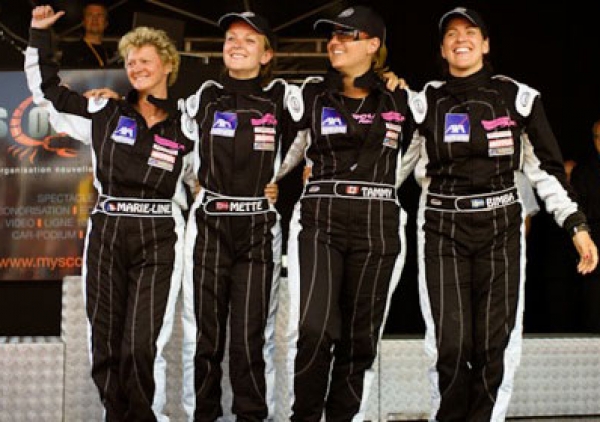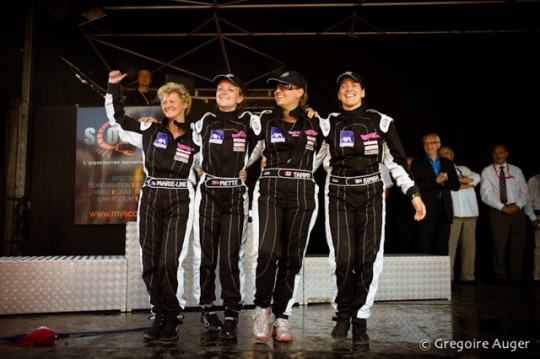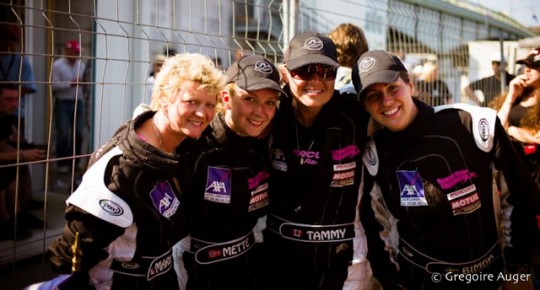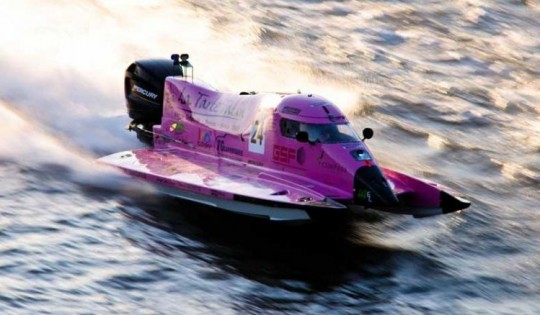The 24 Hours of Rouen is magical, there are no other words that can accurately describe Rouen. It took over 6 months of planning to attend Rouen, countless hours of work, hundreds of peoples support and dedication, as well as an impressive resume of sponsors, including Peters and May, Mercury – Canada, Motul, APBA Historical Society and Teamtech Motorsports Equipment.
I went into Rouen with no expectations and only hope that I could survive the River Seine. At end of the 24 Hours of Rouen, I came out with amazing friends, a heightened respect for the sport and stories that will last a lifetime. I must thank my wonderful team, parents, husband, and sponsors for these memories.
I arrived in Paris, France, Wednesday, May 23rd after flying through the night. My teammate, Bimba Sjoholm met me at the airport. We were then escorted the 2 hours north-west of Paris to Rouen.
Soon after arrival in Rouen, I met Mette Bjerknaes and Marie-Line Hericher, my other teammates. We discussed racing strategies and reviewed the weeks itinerary. The team then checked into our hotel and prepared for a VIP party to meet local sponsors and media.
Thursday and Friday were spent preparing for the event, making adjustments to the boat including throttle cable and seat. We also met race officials and competing teams. Friday evening, the Rouen Yacht Club (RYC) had an incredible drivers presentation. Even though we did not race until Saturday the area was packed with fans, spectators and media. When our team was announced, the girls and I went onstage to a sea of screaming fans and media.
After the drivers presentation the team attended the race briefing which was conducted in French. The officials were very kind and had a smaller intimate drivers meeting in English to help the new drivers orientate themselves to Rouen’s regulations.
Endurance races, especially Rouen, are very unique and extremely different then the sprint races in the USA. It is tremendously important to know the rules.
There are many different rules and regulations in Rouen and these rules are established for safety. One of the most important rules is that each driver must sign in and out during their driving session. Each time a driver signs in, an alcohol test must be completed. U.I.M. and Rouen have a zero tolerance policy for alcohol and drugs and it was strictly enforced throughout the event.
Once a driver signs in, they must make their way to the fueling dock where drivers may switch once refueling is complete. Due to safety issues, drivers cannot be in the boat when refueling takes place. When refueling is complete, drivers quickly strap in to the boat then quickly enter back onto the course.
The course itself is wild with an extremely strong current, large waves, and high wind. The rough water of Rouen gives it a legendary world-wide “bad boy” reputation. Drivers must always pay attention not only to the water conditions, the other race boats, commercial barge traffic but also the docks that are protruding
from the shore. During one of my driving sessions, a boat hit the dock and the metal pole securing the dock in place. Thankfully the driver was okay.
Throughout the weekend, officials, drivers, and crew from competing teams offered help and encouragement to myself and my teammates. It was a wonderful environment to be surrounded by people who also have a passion for the sport.
The Rouen Yacht club had placed indication lights under each bridge, to inform drivers of issues on the course. Our team had issues with radio communication and the lights told us if racing was normal (green), if there was a caution on the course (yellow), or if there was an accident that required us to follow the pace
boat (red). Every few hours we had commercial traffic of large barges that would create bad “rollers” on the course and dredge up debri from the bottom of the River Seine. These massive rollers were extremely hard to maneuver around and would make boats disappear into the water.
Rouen isn’t a place to have the boat perfectly balanced on top of the water to reach the optimal speed, it is a place where survival is key.
At the end of Saturdays competition, the team was excited as we placed 6th in Class II (Formula 2) with our Mercury OptiMax and 14th overall.
Sunday was the teams most challenging day. It consisted of 12 hours of racing and it was going to be exhausting. In the morning, the alarm went off and our boat was headed back to the crane and returned to the paddock. Morten Bjerknaes, Dennis Altis, Fred Wolf and the rest of the crew worked feverishly to isolate and repair an oil pump issue. The problem continued late into the morning, the boat was brought in and out of the paddock numerous time which lost us approximately two hours of racing time. By late Sunday morning, the team had dropped down to 24th position and 8th in our class. We needed to battle back and the odds were certainly against us! The other girls and I were jumping into and out of the boat during fuel changes and trying to recover from the mechanical issues. Although it was a
very long and exhausting day we ended the day 15th overall but still 8th in our class.
The support for our team in the world wide community was shown. Although I had very limited internet access, Bimba and Mette were able to check there Facebook sites and we were encouraged by all of our fans.
There were so many dedicated to cheering on our team. Tony Esposito from P.R. Power, a representative of Peters and May, stayed awake all night and called our team to wish us good luck. He and countless others were glued to the internet all weekend following our progress, challenges, and successes.
This is what racing is all about and this was why our team fought so hard! The world-wide support!
Monday, our final day of competition, we were behind due to oil pump issues and we would have to compete hard and without a hitch to regain our position and get into the top 5 place in our class. I was the second driver in the boat and an hour into my session the alarm went off warning us that the issue had returned. I could not return to the crane because the caution was out and commercial barge traffic was on the course. Finally after 20 minutes of following the pace boat the commercial barge traffic was clear and I was able to take the Moore tunnel boat back to the crane and paddock area to get fixed. Morten, Dennis, my father Fred, and the crew worked in sync and we were back in the water in minutes.
I then returned to the boat, drove it to the fuel dock, and switched with Bimba. My racing time in Rouen was complete. When I looked at the daily results, the team had recovered some of the lost time from the issues on Sunday and was in 9th place overall and 3rd in Class 2 for the day. In Rouen, the results are calculated for the accumulation of laps completed over the three days of racing. The team was excited and as long as we kept pace, we would finish in the top 5 in our class and possibly top 10 overall.
At the end of Rouen, the boats and teams who were able to survive did a parade lap with the drivers on the top of the boats. It is a high honor to do this parade lap and we watched boats that had broken down during the rough 24 hours try to get repaired to participate in the parade lap. As our team jumped on the back of
the Moore boat, I finally became aware of how truly big and amazing this race was. Fans and spectators lined the River Seine, crowded the bridges at times 5 or 6 people deep just to wave to the pilots who participated. As we did our final lap around the course, competing teams raced up to our boat waving and blowing us kisses. Each and every rescue boat and French Federation Official drove along side our team waving at us and giving us the thumbs up. We had now done something that no other team had done. We made history!
We were the first International all-female team that competed in Class 2 and although we did not get a podium we were extremely successful. A team that had never drove together, and had huge language barriers worked and achieved their goal of conquering the roughest inshore (Formula) course in history. Rouen!
A very special thank you to Peters and May, Mercury – Canada, Motul, APBA Historical Society, Teamtech Motorsports Equipment, Spare Air by Submersible System, Fred and Gisela Wolf, Morten Bjerknaes, Dennis Altis, Chris Fairchild, Shaun Torrente, Tony Esposito, my supportive husband Mark, and of course the team for making this happen!
























Introducing She Devil Racing
I was under the thought that Susan (Roush) Mc Clenagahan was compaingi
Sad Day in Motorsports
That's what happens when you let a woman with no interest in racing pr
NASCAR's First Black Woman Driver Talks Race & Racing
And 90% of the official photos she's in are all sexed up. Even when sh
What Type of Male Driver Are You?
As long as a woman gets into the cockpit solely based on merit I don't
F1, No Girls Alowed?
I think the problem is caused by something else. This is F1, this is n